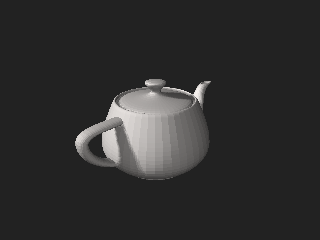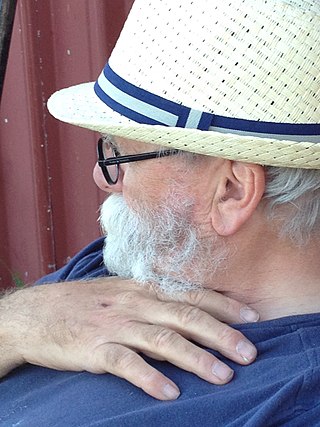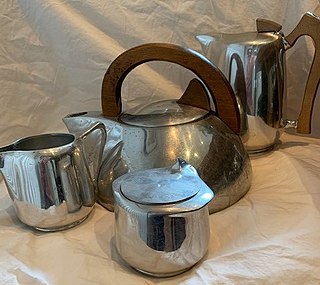
Tate is an institution that houses, in a network of four art galleries, the United Kingdom's national collection of British art, and international modern and contemporary art. It is not a government institution, but its main sponsor is the UK Department for Culture, Media and Sport.

Gilbert Prousch, sometimes referred to as Gilbert Proesch and George Passmore are two artists who work together as the collaborative art duo Gilbert & George. They are known for their formal appearance and manner in performance art, and also for their brightly coloured graphic-style photo-based artworks. In 2017, the artists celebrated their 50th anniversary. In April 2023 Gilbert & George opened the Gilbert & George Centre in Heneage Street, London E1 to showcase their work in regular exhibitions.

A tea bag, or the compound teabag, is a small, porous, sealed bag or packet, typically containing tea leaves or the leaves of other herbs, which is immersed in water to steep and make an infusion. Originally used only for tea, they are now made with other tisanes as well.

A teapot is a vessel used for steeping tea leaves or a herbal mix in boiling or near-boiling water, and for serving the resulting infusion which is called tea. It is one of the core components of teaware. Dry tea is available either in tea bags or as loose tea, in which case a tea infuser or tea strainer may be of some assistance, either to hold the leaves as they steep or to catch the leaves inside the teapot when the tea is poured. Teapots usually have an opening with a lid at their top, where the dry tea and hot water are added, a handle for holding by hand and a spout through which the tea is served. Some teapots have a strainer built-in on the inner edge of the spout. A small air hole in the lid is often created to stop the spout from dripping and splashing when tea is poured. In modern times, a thermally insulating cover called a tea cosy may be used to enhance the steeping process or to prevent the contents of the teapot from cooling too rapidly.

The Utah teapot, or the Newell teapot, is a 3D test model that has become a standard reference object and an in-joke within the computer graphics community. It is a mathematical model of an ordinary Melitta-brand teapot that appears solid with a nearly rotationally symmetrical body. Using a teapot model is considered the 3D equivalent of a "Hello, World!" program, a way to create an easy 3D scene with a somewhat complex model acting as the basic geometry for a scene with a light setup. Some programming libraries, such as the OpenGL Utility Toolkit, even have functions dedicated to drawing teapots.

A kettle, sometimes called a tea kettle or teakettle, is a type of pot specialized for boiling water, commonly with a lid, spout, and handle, or a small electric kitchen appliance of similar shape that functions in a self-contained manner. Kettles can be heated either by placing them on a stove or by their own internal electric heating element in the appliance versions.

A teasmade is a machine for making tea automatically, which was once common in the United Kingdom and some Commonwealth countries. Teasmades generally include an analogue alarm clock and are designed to be used at the bedside, to ensure tea is ready first thing in the morning. Although crude versions existed in Victorian times, they only became practical with the availability of electric versions in the 1930s. They reached their peak in popularity in the 1960s and 1970s. Since then their use has declined, but they started to boast a partial revival in the 2000s, partly as a novelty retro item.

The Hyper Text Coffee Pot Control Protocol (HTCPCP) is a facetious communication protocol for controlling, monitoring, and diagnosing coffee pots. It is specified in RFC 2324, published on 1 April 1998 as an April Fools' Day RFC, as part of an April Fools prank. An extension, HTCPCP-TEA, was published as RFC 7168 on 1 April 2014 to support brewing teas, which is also an April Fools' Day RFC.

Sophie Gengembre Anderson was a French-born British Victorian painter who was also active in America for extended periods. She specialised in genre paintings of children and women, typically in rural settings. She began her career as a lithographer and painter of portraits, collaborating with Walter Anderson on portraits of American Episcopal bishops. Her work, Elaine, was the first public collection purchase of a woman artist. Her painting No Walk Today was purchased for more than £1 million.
The Attenborough Prize is an annual prize associated with the Leicester and East Midlands Open Art Competition. It was originally awarded by Richard Attenborough, aiming to celebrate “emerging talent… in visual arts”

The Memphis Group, also known as Memphis Milano, was an Italian design and architecture group founded by Ettore Sottsass. It was active from 1980 to 1987. The group designed postmodern furniture, lighting, fabrics, carpets, ceramics, glass and metal objects.
Clifford Fishwick was a painter and Principal of Exeter College of Art and Design who exhibited regularly with the Newlyn and Penwith Societies. Fishwick is regarded as an important if underrated figure in post-war British painting.

Chila Kumari Singh Burman is a British artist, celebrated for her radical feminist practice which examines representation, gender and cultural identity. She works across a wide range of mediums including printmaking, drawing, painting, installation and film.
Alison Appleton is a British ceramic designer specializing in porcelain teaware. The collections are influenced by a range of sources including eighteenth-century chinoiserie to fairy tales, using specialist clays and glazes to create different textures and finishes. She works from her design studio in the Baltic Triangle, Liverpool.
Sneha Solanki is an artist and educator. Her practice includes citizen science, performance, sound and installation.
Charles Alfred Mozley was a British artist who was also a teacher. He was a prolific book illustrator and designer of book covers, posters and prints.
Kurt Weiser is an American ceramicist and professor. His work—explorations of the relationship between man and nature through narratives rendered in vivid color—are described as "Eden-like." His work has often taken the form of teapots, vases, and cups, though he has recently begun crafting globes as well. Weiser is currently the Regents Professor at Arizona State University's School of Art.

Roger Michell was a British studio potter, artist, illustrator, poet and writer. Although foremost a potter, his deep insight, curiosity and his singular skills enabled him to work across a range of disciplines. He was a prolific reader, often reading several books a week. His mind was constantly working on future projects, he had a vivid and complex imagination which was evident in his work. He was most known for designing Walking Ware, a tea set on legs with over-sized Mary Jane shoes. During the nineteen seventies and eighties, thousands of these tea sets were sold, either hand made from Lustre Pottery studio or manufactured by Carltonware in Stoke-on-Trent.
Nan Bangs McKinnell (1913–2012) was an American ceramicist and educator. Nan was a founding member of the National Council on Education for the Ceramic Arts, a member of the American Craft Council College of Fellows, along with receiving several awards for her work. James "Jim" McKinnell (1919–2005), her spouse, was also a ceramicist and they made some collaborative work.

Picquot ware is mid-century designed, collectible tableware made of a magnesium-aluminium alloy that they named 'Magnalium' in production in the same Northampton factory from 1947 until 1980. The factory also made vacuum cleaners.
















